![13 Essential Components of a Business Website [with Examples]](https://www.webalive.com.au/wp-content/uploads/2018/10/small-business-website-design-featured-image-727x412.jpg)
13 Essential Components of a Business Website [with Examples]
A 2020 study by Telstra shows that 40.5% of small businesses in Australia don’t have a website. While word of mouth and social media are two alternative ways to reach your potential customers, websites should be the core part of your online presence.

In fact, 1 in 5 potential customers will stop considering your business if you don’t have a website. As you are reading this article, you certainly understand the importance of a website.
But what should a good small business website look like? What are its key components?
You may find that a difficult question to answer. That’s why 60% of small business owners think that it’s too time-consuming to launch a site with the right components.
However, once you know the key components of a business website, you can easily explain how your website should look like to a designer. This knowledge will be helpful if you are looking for a new website or want to redesign your existing one.
So, let us explain these components for you below, along with some great small business website examples.
The basic components of a small business website
1. A notable domain name
A domain name works as an identity of your website, for which it is also often recognized as a website address. If you want to make a good impression on your website, make sure to work on the domain name. Why? Because it is the word by which your business will be known to people on the internet. Thus, making the domain name SEO-friendly and impressive at the same time is the real game here.
While selecting the domain name for your website, you could use some of these tips:
- Use a catchy domain name that is hard to forget because your small business needs to be in everyone’s mind to get exposure.
- Check if there are any other existing websites with a domain name similar to the one you chose. Checking the registered trademark is also a must.
- Avoiding numbers and hyphens is a better choice, as wordy names are easy to remember.
- Choose an easy-to-spell name that is possibly not so wordy or hard to pronounce.
- It is better to use a proper domain extension such as .com, .co, .net, etc.
- It will be great if the domain name conveys any message or is related to your business because internet users often forget nonsensical names.
Example:
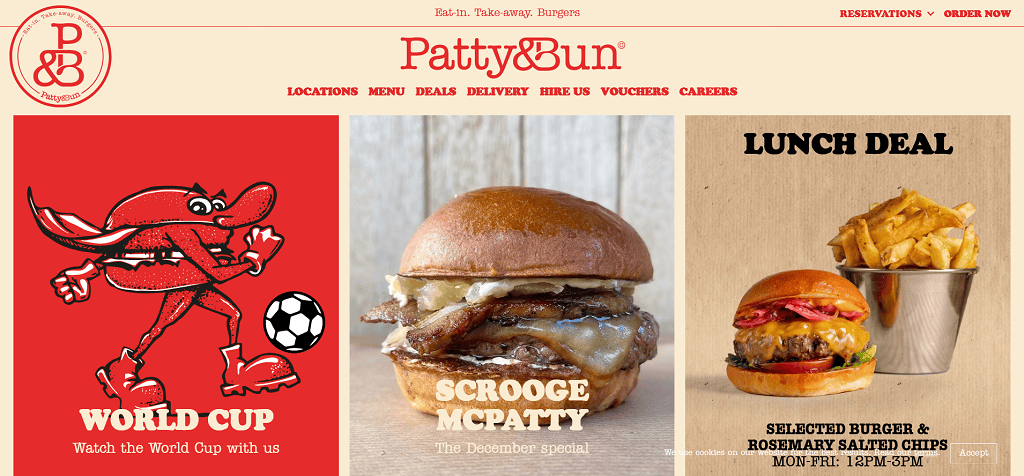
Patty & Bun has most of the features of a domain name that we have been talking about. The name is in simple words and catchy yet meaningful and related to the business.
2. Scalable and secured website hosting
For your website to be viewed on the internet, you need technical help and service from a website host. While searching for your website address, if you want that user to find your website, then connecting your domain name to your hosting provider is a must.
Try choosing a hosting company that has a phone or available chat option so that in case necessary, you can connect with them instantly. Most importantly, make sure you check the regular security maintenance of your hosting company.
The price of the hosting service differs based on the type of package you are taking. Here is a guideline that will help you to get an idea about the price range
Shared server: You can get this for $2 per month, but the reasonable package sometimes comes with its own demerits. In shared hosting, your website performance might suffer due to sharing. There are also chances of being affected if the other shared websites are hacked.
Dedicated server: The price range is from around $100 to $2,000 per month, which is considered the most expensive option for hosting. This secured hosting plan dedicates the physical server machine entirely to your site, and for that, you have all the resources. But for a small business, it could be too luxurious to obtain at the beginning level.
Virtual private server: This hosting plan costs around $20 to $50 per month, which is actually an affordable deal for your small business. A virtual private service is basically a single machine that is divided to act as several machines. For this reason, it has affordability, like shared hosting, with additional security and smoother performance as a dedicated server hosting plan.
Websites of some famous hosting companies are:
- https://www.dreamhost.com
- https://www.bluehost.com
- https://www.inmotionhosting.com
- https://www.godaddy.com/en-in
3. A well-organised navigation bar
85% of customers prefer easy-to-navigate websites. This may sound obvious to you; still, many small business sites don’t have a well-designed navigation bar.
Here’s how to design a user-friendly nav bar:
- The navigation bar should appear at the top of every page, not just the home page. And when a visitor scrolls down your website, the navigation area can stay at the top. This is also called a sticky navbar.
- A visitor must be able to reach all the important pages of your website from the navigation bar. If there are many pages in your site, you may use drop downs to organise the pages.
- Clicking the logo on your navigation bar should take a user to your homepage. The logo is usually placed at the top-left corner.
- As you know, mobile devices are responsible for 50% of web traffic on average; your navigation must work perfectly on a small screen. The best practice is to put all the navbar links into a hamburger menu when a user is viewing your site on a small screen.
Example:
The website of Priority One Coatings follows all the above recommendations and has a very user-friendly navigation bar.
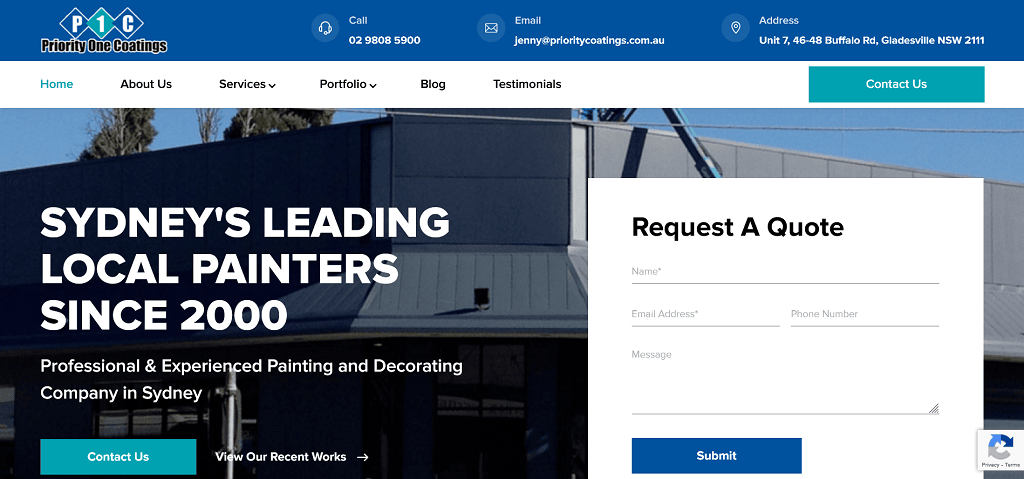
4. Business appropriate design
A small business website should be designed based on who your target audience is. The website of a local locksmith will certainly look different from the website of a local restaurant.
In most cases, your focus should lean toward better user experience rather than over-the-top visuals. Heavy design elements distract your visitors and can potentially slow down your site. You should also stay away from agencies who recycle the same layout for every type of business.
If you want to sell products online, then you need to have all the basic features of an ecommerce website. The online market is really competitive. Even if you are a small business, you can’t afford to ignore eCommerce best practices if you want to turn your visitors into regular customers.
Here are three design principles that every general-purpose small business website should follow –
(A) Responsive design
Mobile friendly or responsive design is mandatory for any small business website. Nothing looks more unprofessional to your visitors than a site that doesn’t render appropriately on mobile devices. A non-responsive webpage has less engagement, poor conversion and low ranking in search results.
(B) UX optimisation
User experience optimisation is the key to any successful small business website design. It’s tempting to get carried away with visuals, colours, and other design elements. But you must have a user-friendly layout, intuitive site structure and a clear information pathway first.
(C) Call to Actions
Each page of your website should have the proper call to actions. A call to action prompts the user to take a step. They are great ways to guide a visitor towards conversion. Some common call to actions are –
Contact Us
Shop Now
Request A Quote
Download Now
Learn More
… etc.
Example:
Native Union has all the features of a small business website with an online store. The site is mobile responsive, has a clean design, proper call to actions (Shop Now, Explore, View Products), and provides an excellent UX for their target customers.
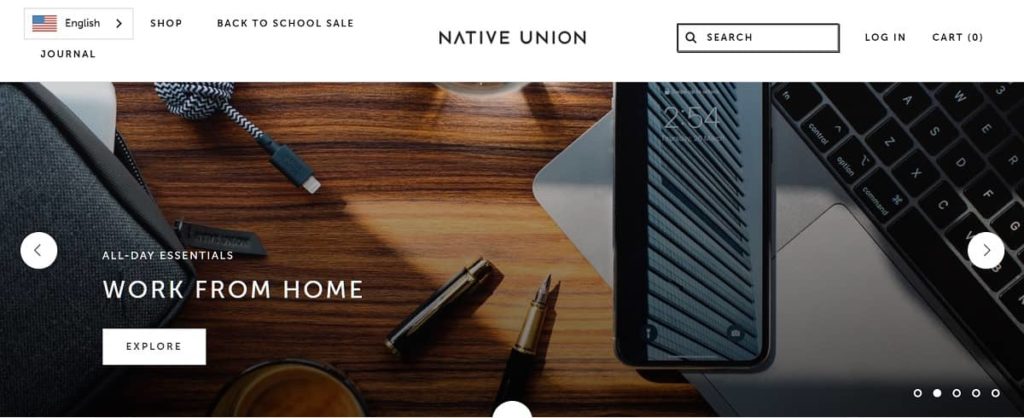
5. Accessible contact details
Surprisingly, a lot of small business websites fail to provide clear contact details to their visitors. To be complete contact information should at least show:
Name of your business
Address of your physical location(s)
Telephone number(s)
Apart from these three (known together as NAT), you should mention your email address and social media accounts on your website. This information not only allows your customers to reach out to you quickly but also helps them identify you as a legitimate business.
Here are some design tips on how to present your contact information:
- Your site should have a separate Contact Us page with a contact form. Link to the Contact us page from the navigation bar.
- Place all your active social media account links at the footer of your website.
- If your business provides direct services (i.e. a painting company, delivery service etc.) place your phone number at the top of every page.
Example:
La Vara’s website and contact us page is a good example of how you should present your contact information.
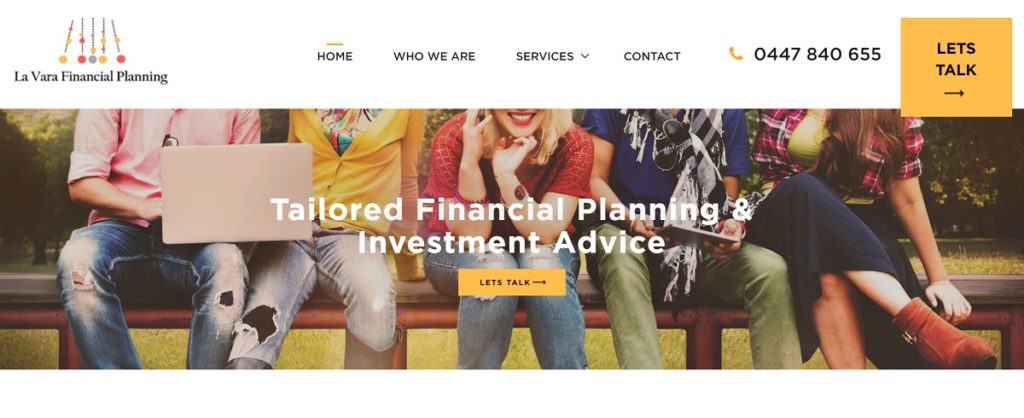
6. Friendly ‘About Us’ page
The About us page gives you a great chance to tell your story to your visitors. It helps to establish a connection between your brand and your potential customers. We see many small business websites don’t give enough focus to their About Us page, which is a great mistake.
Here are some tips to make your About us page better:
- Tell your brand’s story. How did you start? Describe your business journey. People love to know about the business they are buying form.
- Use real images in the About us page. Stock images are a big no-no here. Be authentic.
- Try to connect with your potential customers through your story. Check the example site below to see how it’s done.
Example:
Coelihack is a small Australian business selling kitchen products specifically to those who have gluten intolerance.
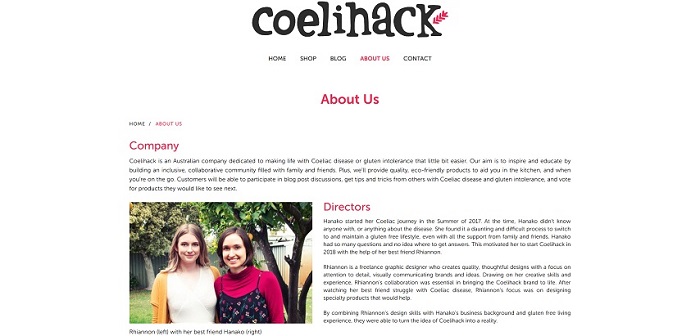
7. On-site blog
You may think on-site blogs are only useful for big companies but, in reality, they are just as helpful for smaller businesses. In fact, an on-site blog may be what keeps you ahead of your local competitors.
Here are some key advantages that a blog gives you-
- An on-site blog shows your visitors that you are a knowledgeable person/brand. It works as an excellent trust signal.
- Relevant and well-written blog articles strengthen your online presence. The blog can play a crucial role in your online marketing strategy and bring new customers to your business.
- Blog content gives you a way to engage with your potential customers. Sharing informative blog posts in your social media will give your business a broader audience and exposure.
But how should your blog look? Many small business website designers don’t give enough attention to the blog, which is a mistake.
Here are some key points regarding a user-friendly blog design –
- The main page of the blog post should give a list of your blog posts in chronological order. Organise your blog posts into several categories. The readers should be able to filter the post list by categories. You may also have a comment section below every blog article.
- Each blog post must start with an eye-catching feature image. Don’t forget to add social media share buttons. The ideal place for these share buttons is on the left margin of each blog post. You should also mention the total number of shares.
- Use a consistent visual style in the images and fonts you use. Make sure that the style you choose goes well with your potential readers.
Example:
Heath & Heather sells organic tea and other related products. Their site is an excellent example of small business website design. Have a look at their blog.
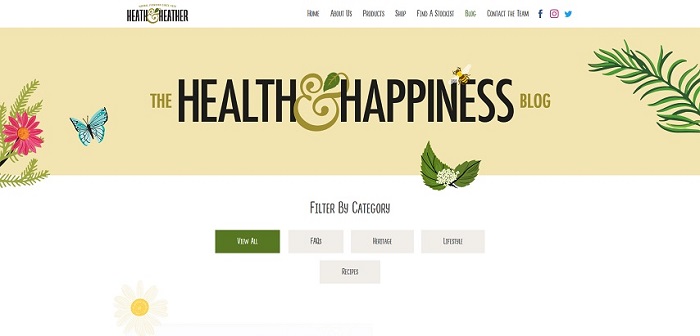
8. Social proof
Social proof is an essential part of any small business website. 85% of customers consider social proof to be as important as personal recommendations. So, your site design should highlight elements like customer testimonials, reviews, client videos, awards and accreditations.
Read more: 5 Ways to Create More Effective Social Proof
No matter what type of social proof you are planning to use, don’t forget to inform your web designer in advance. Proper presentation of social proof is essential to get the most it.
Example:
Premier Painting is a Sydney based painting company. Their website utilises social proof very well. The service accreditations are displayed right after the banner image. Scrolling down the homepage, you’ll see a highlighted client testimonial.
Under the About Us section of the main navigation bar, there are two separate pages on Awards and Testimonials. This is a great example of how a small business should present their social proofs. Take a look – premierpainting.com.au
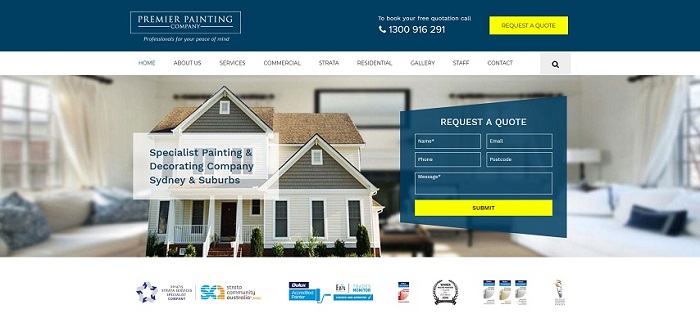
9. Customised CMS
Managing a website can be a hassle, but a good CMS can make it very easy to update and make small changes to your site all by yourself. Choosing the right CMS is also crucial for your website’s performance.
There are many popular CMSs like WordPress and Magento which are used by businesses of all types. However, the one-size-fits-all approach of these popular CMSs makes them too cumbersome and complicated to learn for a busy small business owner.
The alternative is to opt for a customised CMS which is designed specifically for your business. Many business website designers provide customised CMSs for their customers. Ask your agency about these options.
Example:
VC Living is a wholesale furniture seller from Mornington Peninsula in Victoria. This B2B ecommerce site is powered by our custom CMS. It’s straightforward to upload new products, manage inventories and track sales with the custom backend that we have built for them.
Website: vcliving.com.au
10. Basic search engine optimisation
You should think about your SEO strategy right from the start of your website design project. Certain SEO best practices must be followed from the very beginning. Many small business website designers don’t have a clear grasp of search engine optimisation. Ignoring this facet may hurt your business’s growth in the long run.
Selecting the right target keywords for your business, choosing an SEO optimised URL, properly naming your meta tags and structuring your site’s pages in the proper hierarchy are just some of the SEO aspects that need to be addressed during the design process.
Here are some tips to make sure your small business site is SEO optimised –
- Have an idea about the basics of search engine optimisation
- Choose a small business website design agency which also has an SEO team
- Keep a note of the business related keywords your competitors are using to rank in search results
If you are serious about business growth through online marketing, you should keep in touch with an SEO agency right from the start. We provide both web design and SEO service for small businesses. Contact us for a free quote.
11. SSL certificate
A lot of small businesses don’t have a secured website. SSL is essential for any website, even if you are not selling online.
Here’s why –
- If your site doesn’t have SSL, Google Chrome shows a “Not Secure” sign beside your URL. This creates a credibility issue for your website. 84% customers want the websites they visit to be trustworthy.
- Google considers SSL an important ranking factor. So, not having an SSL certificate will hurt your SEO.
- Any small business website with an eCommerce or log-in facility must have SSL to ensure the security of user data.
Once you get the SSL certificate for your website, your site URL will change to HTTPS. The data transmitted between your visitors and your server will be encrypted.
12. Analytics integration and conversion trackers
The main aim of your website is to get targeted visitors and customers. So, you must be able to analyse or visualise customer behaviour data to determine how your site is performing.
Here are some questions that you should be able to answer-
- How many people are coming to your website? What’s the source of this traffic? Are they potential customers or just random surfers?
- How long are your visitors staying on your website? Which pages are getting the most visits?
- Are customers being converted from your website? Conversion means different things for different businesses. A conversion could mean the submission of a form, getting a call or selling a product.
Integrating appropriate tools to the backend of your small business website will let you answer these questions easily. Monitoring your website performance and optimising it based on data can easily put your small business ahead of its competitors.
Most small businesses don’t bother much about visitor data analysis. They are missing an opportunity. If you are interested in incorporating analytical features into your website, let us know.
13. Proper planning of website maintenance
Once you are done with launching the website, don’t consider it to be your final step. To grow your business, the website needs maintenance too. A website maintenance plan is a complete guide that consists of actionable tasks to maintain and improve a site’s overall performance.
Here is a list of the reasons why you need a website maintenance plan:
- Helps avoid frequent website crashes and slow loading processes.
- Ensuring all site elements work properly.
- Maintain security by taking protective measures to reduce the risk of website hacking.
- Confirming regular updates and protecting your website from incompatibility issues and system bugs.
- Better content marketing and user experience are covered.
- Evaluating and improving SEO efforts.
As a small business, if you decide not to involve any third party and do it yourself, then we have some tolls suggestions that might help you.
- Google Analytics
- Pingdom
- Ahrefs
- FileZilla
- Sucuri
5 Ideal examples of small business website design
1. Wildwood Bakery
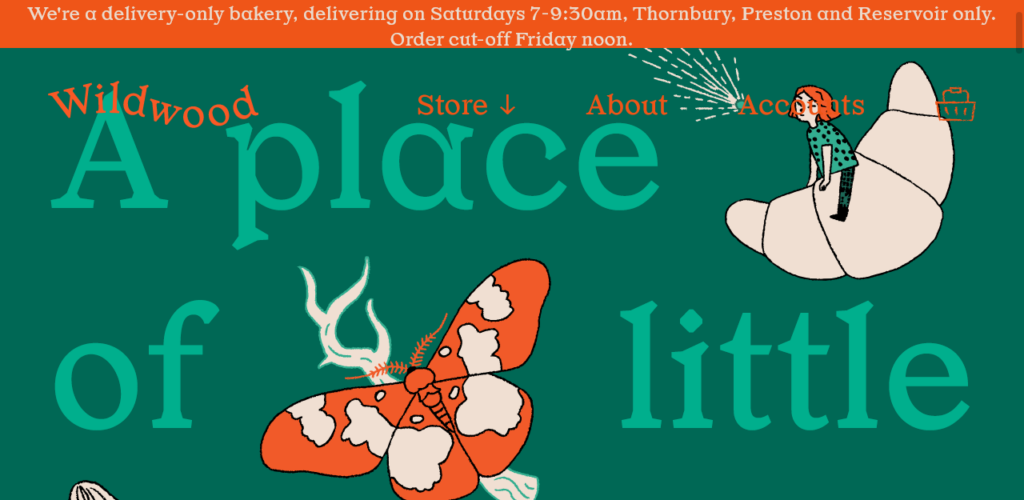
Website: https://www.wildwoodbakery.com.au
The first thing that catches our sight is its green and orange themed attractive page background and all the cute animation details of the little girl on the croissant, butterfly, and wooded elements. The most idyllic feature is the prominent sticky navbar with the “add to cart” logo that is seen in every scroll, making finding and purchasing the desired item a lot easier.
Another worth mentioning aspect is their mouth-watering closeup shot of the bakery items and clear description of price and pre-ordering genre. Also, the footer is larger and more projecting than usual, which draws the attention of anyone. It is a great technique to show the speciality like wholesale or sustainability portrayed by Wildwood Bakery.
2. Milk

Website: https://millk.co
First of all, the unique, meaningful and witty name of the website earns all the praise. The domain name is not so wordy and easy to remember.
The website is clear about its product line, which is basically related to infants, but at the same time, it has created the name in a way that, with the growth of the business, any new product line can be introduced under the same website.
The website design is plain, but with the portraits of the kids on the milky-white-themed background, it looks very eye-soothing. The menu bar is prominent, which means product options are easy to find. Lastly, the product names and little description under each makes the shopping experience a bit easier.
3. Ivory & Deene
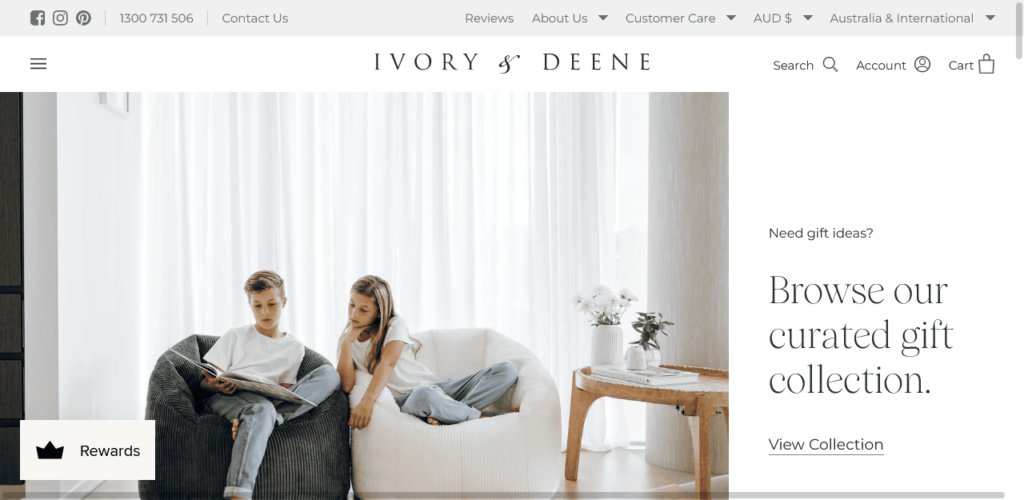
Website: https://ivoryanddeene.com.au
The website of Ivory & Deene can be another great example of a simple yet elegant website design. It also has a navigation bar with all the product varieties and cart that is permanently stuck throughout the scroll.
The product display and photography are done in a sophisticated and minimalistic way that the attention is glued to the product. Small details change a lot for designing a website, so Ivory & Deene included all their reward details in a visible sticky button to show their achievements. The contact details are easily accessible through the direct email option at the bottom of the home page.
4. The People Vs Coffee
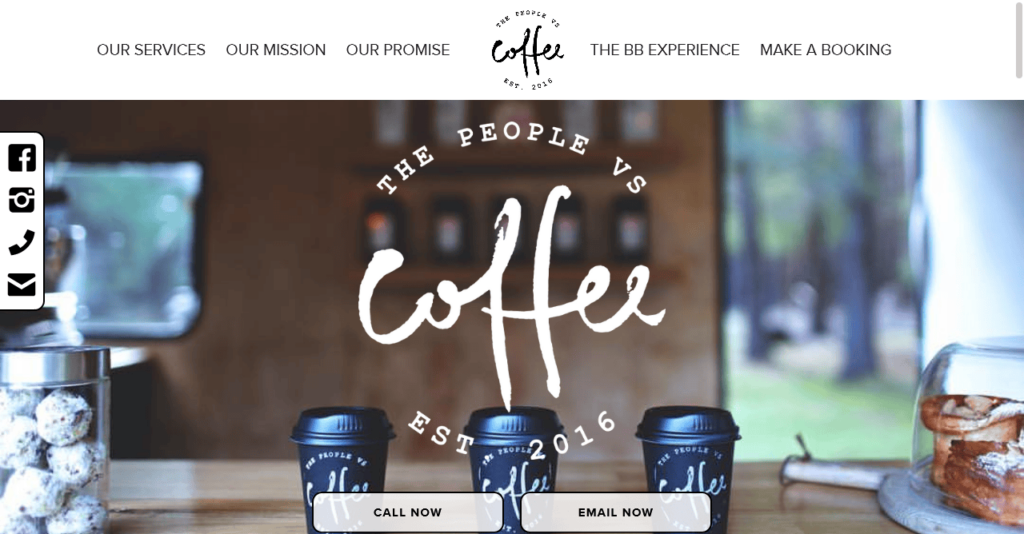
Website: https://www.thepeoplevscoffee.com
The People Vs Coffee is an Australian coffee shop that is pop-up in nature, worked very neatly in their one-page design-based website. The main image shows their mobile coffee service in the background, which is an excellent way to portray the aesthetics of their coffee shop.
They take the art of making coffee quite seriously, and that is seen in the website images. The sticky block on the left, with email, phone and social media links, is a creative way to add the contact links. Another nice detail of the website is the animated visuals while scrolling the page and a little car-moving animation at the bottom to portray their signature coffee car.
5. Boutique: La La Land

Website: https://lalalandshop.com.au
La La Land is an online store presenting products shaped by an artist team. The products are made with care and in an artistic way, which is visible from their website portrayal style.
The website shows the brand’s nature with pink and green hints. Though it also contains a white background that enhances the details and perfection of the colourful designs.
An additional interesting feature is a different coloured block menu for different genres of product lines. Also, the drop-down menu is lively, using words in all caps with a perfectly matching sans-serif font.
Small business website cost
How much does it cost to build a website for a small business?
You can get a very basic small business website for about 750 AUD. But more complex and feature-rich websites will obviously cost you more. Some agencies have small business website packages of different ranges. It’s best to talk with a web design company about your requirements to get an accurate figure.
There are also many online small business website builders. Remember that unless you have a solid understanding of web development, it’s not a good idea to design a website all by yourself. The purpose of a website isn’t just put your business online; it needs to generate leads and get you new customers.
We at WebAlive have built hundreds of websites for small businesses in Australia. If you need a website for your small business, don’t forget to ask us for a free quote.
You read a lot. We like that
Want to take your online business to the next level? Get the tips and insights that matter.


